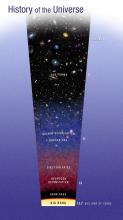Listen to today's episode of StarDate on the web the same day it airs in high-quality streaming audio without any extra ads or announcements. Choose a $8 one-month pass, or listen every day for a year for just $30.
You are here
Hubble Constant
The universe has been expanding since the Big Bang. Knowing how fast it’s expanding can tell us the universe’s age, its fate, and much more. But astronomers can’t agree on what the expansion rate is — different techniques give different results.
The number they’re looking for is known as the Hubble constant. It’s named for Edwin Hubble, who discovered the expansion of the universe and made the first estimate of the rate of expansion.
Today, astronomers use several techniques to measure the Hubble constant, but the best numbers come from two of them.
One technique uses space telescopes to measure the distances to certain types of stars in other galaxies. Those distances are compared to how fast the galaxies are moving away from us as a result of the expanding universe.
The other technique also used a space telescope. It measured tiny differences in the temperature of the universe soon after the Big Bang.
Both techniques have produced precise numbers. But they don’t match. They’re off by less than 10 percent. But there’s so little wiggle room in either number that there’s no way to reconcile them — even when you account for dark energy, which appears to be causing the universe to expand faster as it ages.
It’s possible that the expansion rate was different early on. But it’s also possible that there’s a lot of work to do to figure out the Hubble constant — the key number in understanding the history of the universe.
Script by Damond Benningfield




